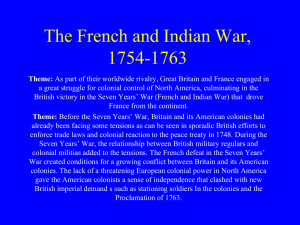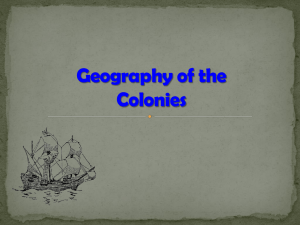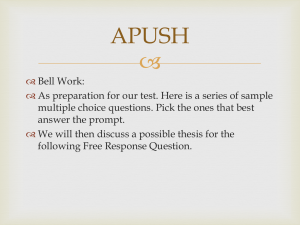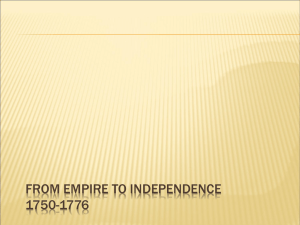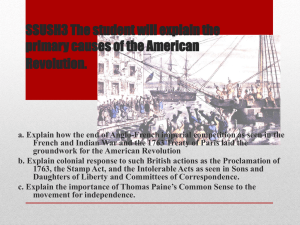Guidebook Chap 6
advertisement
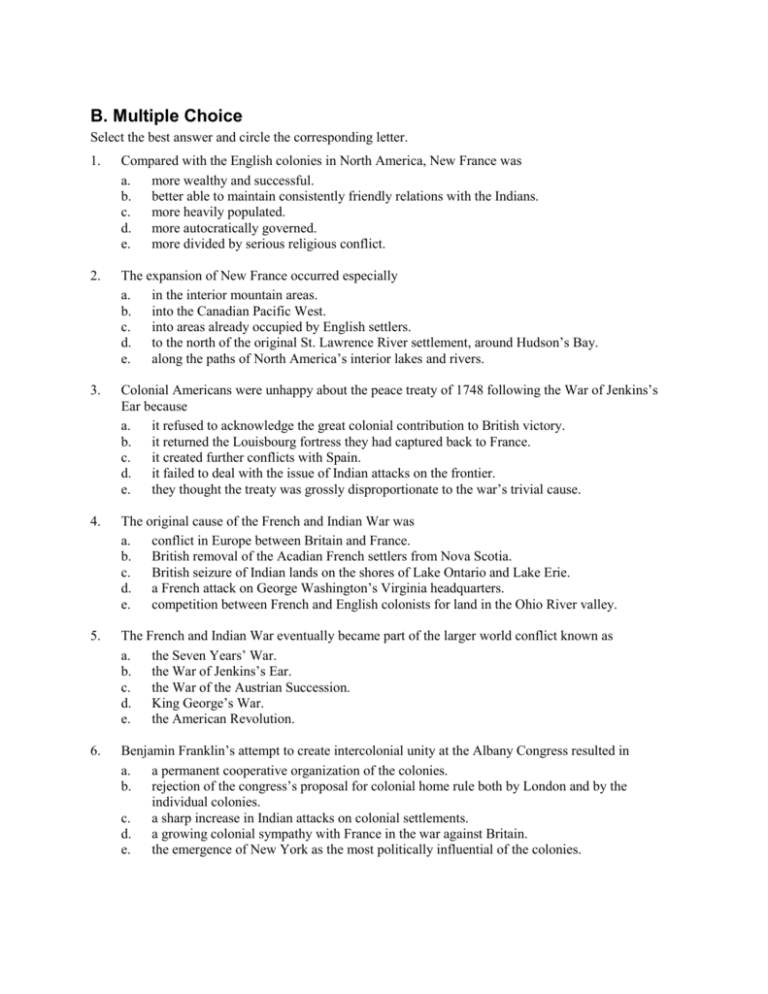
B. Multiple Choice Select the best answer and circle the corresponding letter. 1. Compared with the English colonies in North America, New France was a. more wealthy and successful. b. better able to maintain consistently friendly relations with the Indians. c. more heavily populated. d. more autocratically governed. e. more divided by serious religious conflict. 2. The expansion of New France occurred especially a. in the interior mountain areas. b. into the Canadian Pacific West. c. into areas already occupied by English settlers. d. to the north of the original St. Lawrence River settlement, around Hudson’s Bay. e. along the paths of North America’s interior lakes and rivers. 3. Colonial Americans were unhappy about the peace treaty of 1748 following the War of Jenkins’s Ear because a. it refused to acknowledge the great colonial contribution to British victory. b. it returned the Louisbourg fortress they had captured back to France. c. it created further conflicts with Spain. d. it failed to deal with the issue of Indian attacks on the frontier. e. they thought the treaty was grossly disproportionate to the war’s trivial cause. 4. The original cause of the French and Indian War was a. conflict in Europe between Britain and France. b. British removal of the Acadian French settlers from Nova Scotia. c. British seizure of Indian lands on the shores of Lake Ontario and Lake Erie. d. a French attack on George Washington’s Virginia headquarters. e. competition between French and English colonists for land in the Ohio River valley. 5. The French and Indian War eventually became part of the larger world conflict known as a. the Seven Years’ War. b. the War of Jenkins’s Ear. c. the War of the Austrian Succession. d. King George’s War. e. the American Revolution. 6. Benjamin Franklin’s attempt to create intercolonial unity at the Albany Congress resulted in a. a permanent cooperative organization of the colonies. b. rejection of the congress’s proposal for colonial home rule both by London and by the individual colonies. c. a sharp increase in Indian attacks on colonial settlements. d. a growing colonial sympathy with France in the war against Britain. e. the emergence of New York as the most politically influential of the colonies. 7. The British forces suffered crushing early defeats in the French and Indian War under the overall command of a. General Braddock. b. General Washington. c. General Wolfe. d. General Montcalm. e. Admiral Jenkins. 8. The fundamental flaw in British strategy before William Pitt gained control of the London government was it a. devoted all its energy to winning naval victories, while ignoring the war on the land. b. failed to elicit the full support and cooperation of its Indian allies. c. tried to attack numerous French wilderness forts simultaneously, instead of concentrating on the key French fortresses. d. refused to give sufficient forces to its best colonial general, George Washington. e. concentrated on the St. Lawrence River valley rather than attacking the French in the more vulnerable Mississippi River valley. 9. The decisive event in the French-British contest for North America was the a. British capture of Fort Duquesne. b. British victory in the Battle of Quebec. c. American capture of the Louisbourg fortress. d. British attack on the French West Indies. e. defeat of the Indian leader Pontiac through the distribution of smallpox-infected blankets. 10. Among the factors that tended to promote British colonists’ intercolonial unity during the French and Indian War was a. their religious unity. b. their common language and shared wartime experience. c. their ethnic and social harmony. d. improved transportation and settlement of boundary disputes. e. their desire to seize French land. 11. The French and Indian War weakened interior Indian peoples like the Iroquois and Creeks by a. establishing new American settlements on their territory. b. eliminating their most effective leaders. c. ending their hopes for diplomatic recognition in Europe. d. giving control of the Great Lakes to the British colonists. e. removing their French and Spanish allies from Canada and Florida. 12. Perhaps the most enduring result of France’s years of colonial rule in North America was a. a permanent French-Canadian minority in Quebec in Canada. b. continuing warfare into the nineteenth century between Britain and France over North America. c. the legal recognition of Roman Catholicism as a minority religion in all the British colonies. d. the creation of a rich tradition of French cuisine and fashion in North America. e. support for the French Revolution by Britain’s former North American colonists. 13. The British Proclamation of 1763 a. was welcomed by most American colonists. b. angered colonists who thought that it deprived them of the fruits of victory. c. was aimed at further suppressing the French population of Canada. d. halted American westward settlement for several years. e. encouraged Daniel Boone and his followers to cross the Appalachians into Kentucky. 14. The French and Indian War created conflict between the British and the American military because a. the American soldiers had failed to support the British military effort. b. the British regulars had carried the brunt of the fighting. c. the Americans opposed the forced resettlement of French Acadians (“Cajuns”) to Louisiana. d. American soldiers refused to accept orders from British officers. e. British officers treated the American colonial militia with contempt. 15. The most significant effect on the colonists of the French defeat in North America was a. to increase their gratitude to Britain for defending them in the war. b. to create new threats to colonial expansion from Spain and the Indians. c. to reduce the colonies’ reliance on Britain for protection and increase their sense of independence. d. to focus colonial energies on trade. e. the creation of a strong intercolonial political organization. D. Matching People, Places, and Events Match the person, place, or event in the left column with the proper description in the right column by inserting the correct letter on the blank line. 1. ___ Samuel de Champlain 2. ___ Robert de la Salle 3. ___ Albany 4. ___ War of Austrian Succession 5. ___ Fort Duquesne 6. ___ George Washington 7. ___ Benjamin Franklin 8. ___ General Braddock 9. ___ William Pitt 10. ___ Plains of Abraham 11. ___ Seven Years’ War 12. ___ Pontiac 13. ___ Proclamation of 1763 14. ___ New Orleans 15. ___ Acadians (Cajuns) a. Advocate of colonial unity at a 1754 meeting in upstate New York b. British document that aroused colonial anger but failed to stop frontier expansion c. French colonists in Nova Scotia brutally uprooted by the victorious British and shipped to Louisiana d. Conflict that started with the War of Jenkins’s Ear and ended with the return of Louisbourg to France e. Strategic French outpost at the mouth of the Mississippi f. Indian leader whose frontier uprising caused the British to attempt to limit colonial expansion g. Blundering British officer whose defeat gave the advantage to the French and Indians in the early stages of their war h. The Father of New France, who established a crucial alliance with the Huron Indians i. Site of the death of Generals Wolfe and Montcalm, where France’s New World empire also perished j. Strategic French stronghold; later renamed after a great British statesman k. Militia commander whose frontier skirmish in Pennsylvania touched off a world war l. Site of a meeting that proposed greater unity and home rule among Britain’s North American colonies m. Conflict that began with George Washington’s skirmish in Ohio and ended with the loss of France’s North American empire n. French empire builder who explored the Mississippi Basin and named it after his monarch o. Splendid British orator and organizer of the winning strategy against the French in North America


